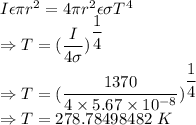
At our distance from the Sun, the intensity of solar radiation is 1 370 W/m2. The temperature of the Earth is affected by the greenhouse effect of the atmosphere. This phenomenon describes the effect of absorption of infrared light emitted by the surface so as to make the surface temperature of the Earth higher than if it were airless. For comparison, consider a spherical object of radius r with no atmosphere at the same distance from the Sun as the Earth.
Assume its emissivity is the same for all kinds of electromagnetic waves and its temperature is uniform over its surface.
Compute its steady-state temperature. Is it chilly?

Answers: 2
Other questions on the subject: Physics

Physics, 21.06.2019 22:10, smiley0326
Ascrew incorporates which other simple machine? lever wheel and axle inclined plane pulley
Answers: 3

Physics, 22.06.2019 01:40, onegirl435
Lin yao looks at the back of a spoon. how should she describe her reflection? upside down and smaller upside down and larger right-side up and smaller right-side up and larger
Answers: 1

Physics, 22.06.2019 07:30, anonymous1813
Some material consisting of a collection of microscopic objects is kept at a high temperature. a photon detector capable of detecting photon energies from infrared through ultraviolet observes photons emitted with energies of 0.3 ev, 0.5 ev, 0.8 ev, 2.0ev, 2.5ev, and 2.8ev. these are the only photon energies observed. (a) draw and label a possible energy-level diagram for one of the microscopic objects, which has four bound states. on the diagram, indicate the transitions corresponding to the emitted photons. explain briefly. (b) would a spring–mass model be a good model for these microscopic objects? why or why not? (c) the material is now cooled down to a very low temperature, and the photon detector stops detecting photon emissions. next, a beam of light with a continuous range of energies from infrared through ultraviolet shines on the material, and the photon detector observes the beam of light after it passes through the material. what photon energies in this beam of light are observed to be significantly reduced in intensity (“dark absorption lines”)? explain briefly.
Answers: 3
Do you know the correct answer?
At our distance from the Sun, the intensity of solar radiation is 1 370 W/m2. The temperature of the...
Questions in other subjects:

Mathematics, 06.04.2021 20:40

Mathematics, 06.04.2021 20:40







Social Studies, 06.04.2021 20:40



 = Stefan-Boltzmann constant =
= Stefan-Boltzmann constant = 







